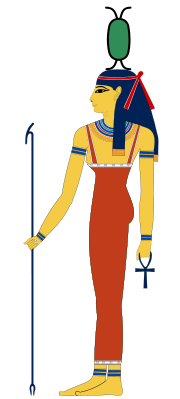

Nit (Net, Neit, Neith) was the predynastic goddess of war and weaving, the goddess of the Red Crown of Lower Egypt and the patron goddess of Zau (Sau, Sai, Sais) in the Delta. In later times she was also thought to have been an androgynous demiurge - a creation deity - who had both male and female attributes. The Egyptians believed her to be an ancient and wise goddess, to whom the other gods came if they could not resolve their own disputes.
It is thought that Neith may correspond to the goddess Tanit, worshipped in north Africa by the early Berber culture (existing from the beginnings of written records) and through the first Punic culture originating from the founding of Carthage by Dido. Ta-nit, meaning in Egyptian the land of Nit, also was a sky-dwelling goddess of war, a virginal mother goddess and nurse, and, less specifically, a symbol of fertility.
Her symbol is remarkably similar to the Egyptian ankh and her shrine, excavated at Sarepta in southern Phoenicia, revealed an inscription that related her securely to the Phoenician goddess Astarte (Ishtar). Several of the major Greek goddesses also were identified with Tanit by the syncretic, interpretatio graeca, which recognized as Greek deities in foreign guise the deities of most of the surrounding non-Hellene cultures. A Hellenistic royal family ruled over Egypt for three centuries, a period called the Ptolemaic dynasty until the Roman conquest in 30 A.D.
Neith was a goddess of war and of hunting and had as her symbol, two crossed arrows over a shield. Her symbol also identified the city of Sais. This symbol was displayed on top of her head in Egyptian art. In her form as a goddess of war, she was said to make the weapons of warriors and to guard their bodies when they died.
Her name also may be interpreted as meaning, water. In time, this meaning led to her being considered as the personification of the primordial waters of creation. She is identified as a great mother goddess in this role as a creator.
Neith's symbol and part of her hieroglyph also bore a resemblance to a loom, and so later in the history of Egyptian myths, she also became goddess of weaving, and gained this version of her name, Neith, which means weaver. At this time her role as a creator changed from being water-based to that of the deity who wove all of the world and existence into being on her loom.
As a goddess of weaving and the domestic arts she was a protector of women and a guardian of marriage, so royal woman often named themselves after Neith, in her honour. Since she also was goddess of war, and thus had an additional association with death, it was said that she wove the bandages and shrouds worn by the mummified dead as a gift to them, and thus she began to be viewed as a protector of one of the Four sons of Horus, specifically, of Duamutef, the deification of the canopic jar storing the stomach, since the abdomen (often mistakenly associated as the stomach) was the most vulnerable portion of the body and a prime target during battle. It was said that she shot arrows at any evil spirits who attacked the canopic jar she protected.
In the late pantheon of the Ogdoad myths, she became identified as the mother of Ra and Apep. When she was identified as a water goddess, she was also viewed as the mother of Sobek, the crocodile. It was this association with water, i.e. the Nile, that led to her sometimes being considered the wife of Khnum, and associated with the source of the River Nile. She was associated with the Nile Perch as well as the goddess of the triad in that cult center.
As the goddess of creation and weaving, she was said to reweave the world on her loom daily.
The Greek historian, Herodotus (c. 484-425 BC), noted that the Egyptian citizens of Sais in Egypt worshipped Neith and that they identified her with Athena. The Timaeus, a Socratic dialogue written by Plato, mirrors that identification with Athena.
Plutarch (46 - 120 A.D.), said the temple of Neith (of which nothing now remains) bore the inscription:
I am All That Has Been, That Is, and That Will Be.
No mortal has yet been able to lift the veil that covers Me.
In much later times, her association with war and death, led to her being identified with Nephthys (and Anouke or Ankt). Nephthys became part of the Ennead pantheon, and thus considered a wife of Set. Despite this, it was said that she interceded in the kingly war between Horus and Set, over the Egyptian throne, recommending that Horus rule.
Anouke, a goddess from Asia Minor was worshiped by immigrants to ancient Egypt. This war goddess was shown wearing a curved and feathered crown and carrying a spear, or bow and arrows. Within Egypt, she was later assimilated and identified as Neith, who by that time had developed her aspects as a war goddess.
In art, Neith sometimes appears as a woman with a weaversÕ shuttle atop her head, holding a bow and arrows in her hands. At other times she is depicted as a woman with the head of a lioness, as a snake, or as a cow.
Sometimes Neith was pictured as a woman nursing a baby crocodile, and she was titled "Nurse of Crocodiles". As the personification of the concept of the primordial waters of creation in the Ogdoad theology, she had no gender. As mother of Ra, she was sometimes described as the "Great Cow who gave birth to Ra".
A great festival, called the Feast of Lamps, was held annually in her honor and, according to Herodotus, her devotees burned a multitude of lights in the open air all night during the celebration.
There also is evidence of an resurrection cult involving a woman dying and being brought back to life that was connected with Neith.
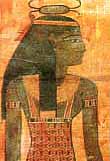
Generally depicted as a woman, Nit was shown either wearing her emblem - either a shield crossed with two arrows, or a weaving shuttle - or the Red Crown of Lower Egypt. Nit was probably linked with the crown of Lower Egypt due to the similarities between her name, and the name of the crown - nt . Similarly, her name was linked to the root of the word for 'weave' - ntt (which is also the root for the word 'being'). She was also often shown carrying a bow and arrows, linking her to hunting and warfare, or a sceptre and sceptre and the ankh sign of life. She was also shown in the form of a cow, though this was very rare.
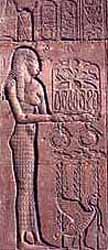
In late dynastic times there is no doubt that Nit was regarded as nothing but a form of Hathor, but at an earlier period she was certainly a personification of a form of the great, inert, primeval watery mass out of which sprang the sun god Ra...
- The Gods of the Egyptians, E. A. Wallis Budge

As the mother of Ra, the Egyptians believed her to be connected with the god of the watery primeval void, Nun. (Her name might have also been linked to a word for water - nt - thus providing the connection between the goddess and the primeval waters.) Because the sun god arose from the primeval waters, and with Nit being these waters, she was thought to be the mother of the sun, and mother of the gods. She was called 'Nit, the Cow Who Gave Birth to Ra' as one of her titles. The evil serpent Apep, enemy of Ra, was believed to have been created when Nit spat into the waters of Nun, her spittle turning into the giant snake. As a creatrix, though, her name was written using the hieroglyph of an ejaculating phallus - - a strong link to the male creative force a hint as to her part in the creation of the universe.
According to the Iunyt (Esna) cosmology the goddess emerged from the primeval waters to create the world. She then followed the flow of the Nile northward to found Zau in company with the subsequently venerated lates-fish. There are much earlier references to Nit's association with the primordial flood-waters and to her demiurge: Amenhotep II (DynastyXVIII) in one inscription is the pharaoh 'whose being Nit moulded'; the papyrus (Dynasty XX) giving the account of the struggle between Horus and Set mentions Nit 'who illuminated the first face' and in the sixth century BC the goddess is said to have invented birth.
There is confusion as to the Emblem of Nit - originally it was of a shield and two crossed arrows. This was her symbol from the earliest times, and she was no doubt a goddess of hunting and war since predynastic times. The symbol of her town, Zau, used this emblem from early times, and was used in the name of the nome of which her city was the capital. The earliest use of this Emblem was used in the name of queen Nithotep, 'Nit is Pleased', who seems to have been the wife of Aha "Fighter" Menes of the 1st Dynasty. Another early dynastic queen, Mernit, 'Beloved of Nit', served as regent around the time of king Den.
Her most ancient symbol is the shield with crossed arrows, which occurs in the early dynastic period... This warlike emblem is reflected in her titles 'Mistress of the Bow... Ruler of Arrows'.
- A Dictionary of Egyptian Gods and Goddesses
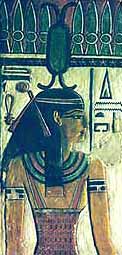
The later form of the Emblem is what some people believe to be a weaving shuttle. It is possible that the symbols were confused by the Egyptians themselves, and so she became a goddess of weaving and other domestic arts. It was claimed, in one version of her tale, that she created the world by weaving it with her shuttle.
She was linked to with a number of goddesses including Isis, Bast, Wadjet, Nekhbet, Mut and Sekhmet. As a cow, she was linked to both Nut and Hathor. She was also linked to Tatet, the goddess who dressed the dead, and was thus linked to preservation of the dead. This was probably due to being a weaver goddess - she was believed to make the bandages for the deceased.
She might have also been linked to Anubis and Wepwawet (Upuaut), because one of her earliest titles was also 'Opener of the Ways'. She was also one of the four goddesses - herself, Isis, Nephthys and Serqet - who watched over the deceased as well as each goddess protecting one of the four sons of Horus. Nit watched over the east side of the sarcophagus and looked after the jackal-headed Duamutef who guarded the stomach of the dead. Also, during the earliest times, weapons were placed around the grave to protect the dead, and so her nature of a warrior-goddess might have been a direct link to her becoming a mortuary goddess.
Her son, other than the sun god Ra, was believed to be Sobek, the crocodile god. She was regarded as his mother from early times - the two were mentioned as mother and son in the pyramid of Unas - and one of her titles was 'Nurse of Crocodiles'. She was also regarded, during the Old Kingdom, as the wife of Set, though by later times this relationship was dropped and she became the wife of Sobek instead. In Upper Egypt she was married to the inundation god, Khnum, instead.
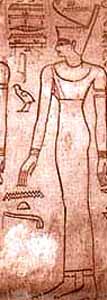
"Give the office of Osiris to his son Horus! Do not go on committing these great wrongs, which are not in place, or I will get angry and the sky will topple to the ground. But also tell the Lord of All, the Bull who lives in Iunu (On, Heliopolis), to double Set's property. Give him Anat and Astarte, your two daughters, and put Horus in the place of his father."
- Nit Addressing the Gods Myth and Symbol in Ancient Egypt